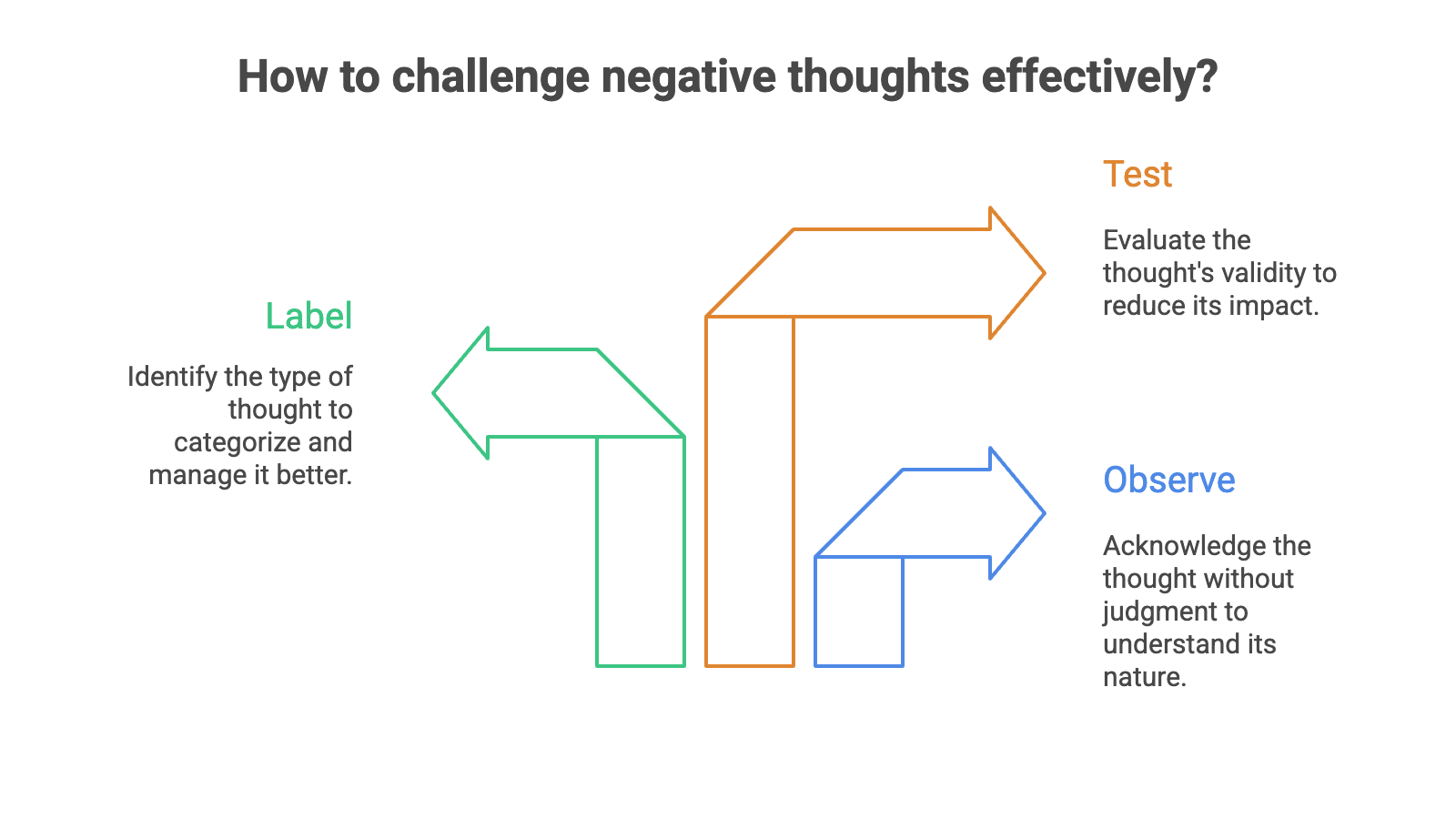Automatic Negative Thoughts (ANTs): What Are They and Why Do They Matter?
Automatic negative thoughts (ANTs) are the quick, harsh stories your mind tells without asking. This short guide explains how they tend to show up differently with anxiety versus depression and gives you simple, evidence‑based steps you can try today. The aim is balanced thinking—not forced positivity—kept practical for everyday life in DC.
What are “automatic negative thoughts,” in plain language?
Automatic negative thoughts—often called ANTs—are the quick, habitual comments your mind makes about you, other people, or the future. They pop up fast, without permission, and tend to lean negative. This is partly how the brain tries to keep you safe: it scans for risk and remembers past hurts so you don’t repeat them. Research shows these negative self‑beliefs can persist even when symptoms improve, which is why learning to spot and update them matters.
Key idea: we’re aiming for realistic and compassionate thinking—not forced positivity.
How do ANTs typically show up with anxiety?
With anxiety, ANTs often sound like alarms. You might jump to the worst‑case scenario (catastrophizing), overestimate how likely something bad is (probability overestimation), spin out in endless what‑ifs, or assume you know what others think (mind reading). These patterns are tied to repetitive negative thinking and hiccups in cognitive control, which can keep worry loops running. Your body joins in: heart rate spikes, muscles tense, attention narrows, and you start scanning for danger. Behavior often shrinks—avoiding a task, delaying a reply, or canceling plans.
Quick example: An ambiguous email from your manager arrives at 4:58 pm. The ANT says, “I’m in trouble.” Your body tightens; you replay mistakes; you avoid replying.
What quick, evidence‑based moves help with anxiety‑driven ANTs?
Identifying and labeling ANTs is the first step in managing them.
- Name the ANT. Label the pattern (“There’s catastrophizing”) to create distance and choice. Identifying ANTs is crucial for recognizing the different types of automatic negative thoughts that influence your mood and behavior.
- Two‑question check. Ask: What’s the concrete evidence for this thought? Then: What else is reasonably possible? This mirrors a two‑stage CBT approach to disputing automatic thoughts.
- Probability dial. If your mind says there’s a 90% chance of disaster, pause and give a sober estimate. Then list 2–3 non‑catastrophic outcomes that also fit the facts.
- Approach in inches. Take one small step toward the thing you’re avoiding (send one clarifying question, draft the first line, walk into the room). Exposure in small bites teaches your brain you can handle it.
- Night‑time note. If worry visits at bedtime, “park” it: jot a one‑line summary and a tiny plan for morning. Give your brain a container so it doesn’t keep knocking.
Managing anxiety-driven ANTs is a process that requires ongoing practice and patience.
How do ANTs typically show up with depression?
With depression, ANTs often feel heavy and certain. Common patterns include over‑generalization(global, stable conclusions), mental filter (only noticing the negative), all‑or‑nothing thinking, and bleak, hopeless predictions. Studies consistently find that people experiencing depression report more frequent and intense automatic negative thoughts than non‑depressed peers.
Quick example: One task went poorly → “I’m failing at everything.”
What quick, evidence‑based moves help with depression‑linked ANTs?
- Behavior first. Start with one tiny, values‑based action (behavioral activation) before debating the thought—this jump‑starts energy and gives you new data. In some contexts, behavioral activation can reduce ANTs as effectively as (or better than) cognitive restructuring.
- Zoom the lens. Look for exceptions and data points that don’t fit the bleak story; this weakens over‑generalization.
- Specificity shift. Move from global (“always/never”) to specific, time‑bound statements.
- Fair‑minded reframe. Draft the balanced alternative you’d offer a friend, focusing on generating more helpful thoughts that support well-being.
Over time, even after a depressive episode lifts, some memory and thinking biases can linger and nudge ANTs back in—so continuing skills practice helps resilience. Fostering positive automatic thoughts is also important for long-term recovery and mental health.
How do I challenge thoughts without getting into a fight with my brain?
Don’t try to suppress thoughts; observe, label, and test. That simple loop reduces the grip of ANTs and builds flexible thinking. ANTs can shape our perception of the world, often making experiences and environments seem more negative than they are. If you notice you’re stuck in a repetitive negative thinking rut, gently return to a small, concrete action to break the loop. Remember, thoughts affect emotions and behavior, so recognizing these patterns is key to changing how you feel and act.
Can I do a two‑minute ANT check on my phone?
Yes. Try a micro thought record: Situation → Thought → Feeling → Balanced response (one sentence each), making sure to acknowledge and explore your feelings as part of the process. Then add a “next small step” to gather new evidence (email one question, take a 5‑minute walk, start a 2‑minute task). Over days and weeks, this practice helps loosen rigid beliefs that feed low mood. Research has shown these techniques are especially effective for university students experiencing negative automatic thoughts.
When is it time to get extra support?
- If ANTs are daily, intense, or disrupting sleep, work, or relationships.
- If safety concerns, trauma triggers, or panic attacks are present.
- Therapy provides structured tools—cognitive restructuring, behavioral activation, and exposure—practiced with guidance. These approaches are well‑studied ways to change how you think and feel in daily life. Cognitive therapy is a structured approach that specifically targets automatic negative thoughts (ANTs) and negative thinking patterns.
If you are struggling, it is important to consult a mental health professional for support and to discuss therapy options tailored to your needs.
Next steps at the Therapy Group of DC
If you’re ready to work on automatic negative thoughts with a clinician, our Therapy Group of DC team in Dupont Circle uses evidence‑based therapy—including CBT, behavioral activation, and exposure—to treat anxiety and depression in a warm, collaborative way. You can start by choosing a therapist who fits your goals and availability.
Frequently Asked Questions About Automatic Negative Thoughts
What are automatic negative thoughts and how do they affect mental health?
Automatic negative thoughts are subconscious thoughts that occur without conscious control, often reflecting negative thinking patterns. They can lead to negative emotions such as anxiety and depression, impacting overall mental health and well-being by distorting reality and reinforcing unhealthy beliefs.
How can cognitive behavior therapy help with automatic negative thoughts?
Cognitive behavior therapy (CBT) is an effective treatment that helps individuals identify and challenge their automatic negative thoughts. By restructuring cognitive self statements and practicing healthier mindset techniques, CBT aids in reducing the frequency and intensity of these thoughts, promoting positive thinking and emotional intelligence.
Are there practical ways to identify and manage automatic negative thoughts?
Yes. Practical ways include using thought records, practicing mindfulness to stay in the present moment, and completing the automatic thoughts questionnaire to recognize common ANTs. These tools help in identifying subconscious thoughts and replacing negative automatic thoughts with more balanced, positive ones.
When should someone seek help from mental health professionals for automatic negative thoughts?
If automatic negative thoughts are persistent, intense, or interfere with daily life and social situations, it is advisable to consult mental health professionals. Conditions such as anxiety disorders or social anxiety disorder often benefit from clinical psychology interventions and commitment therapy to improve mental health and overall quality of life.


